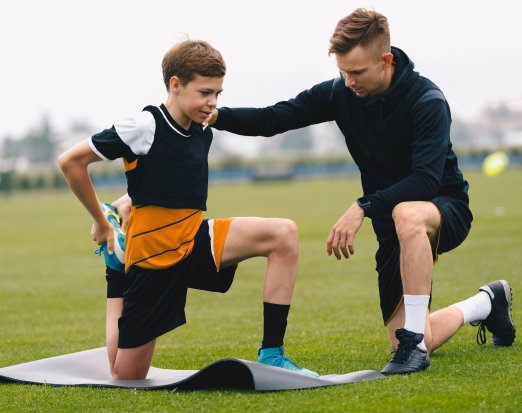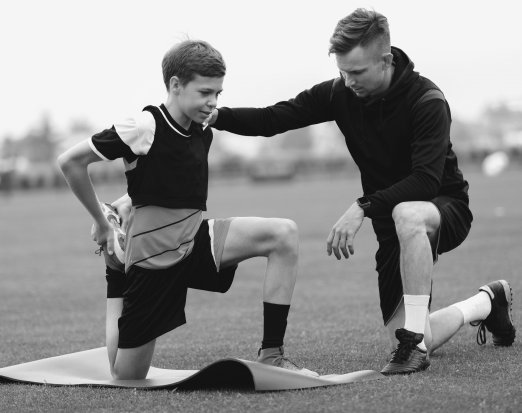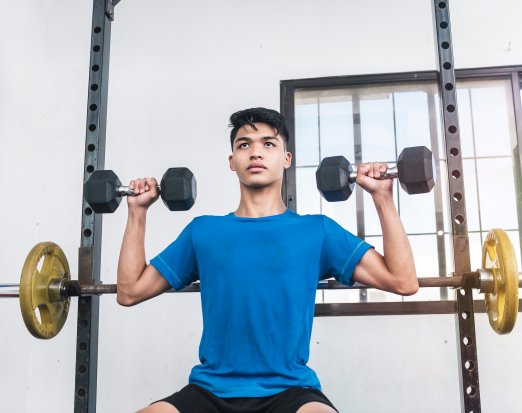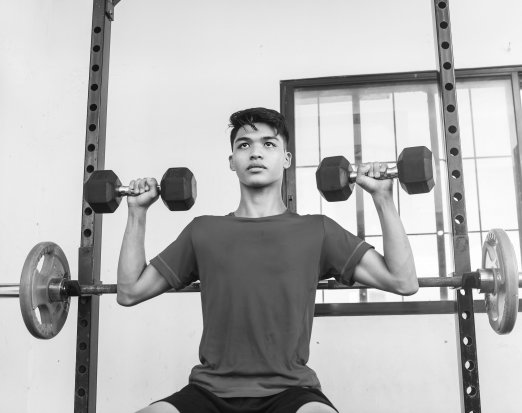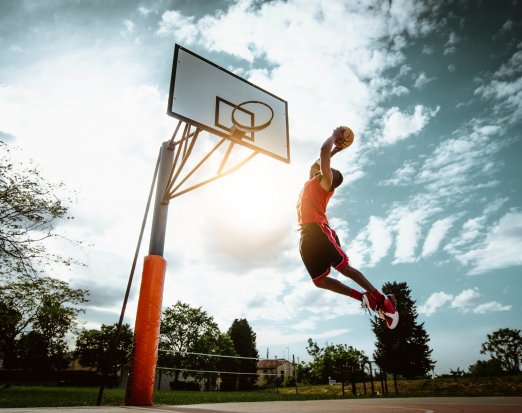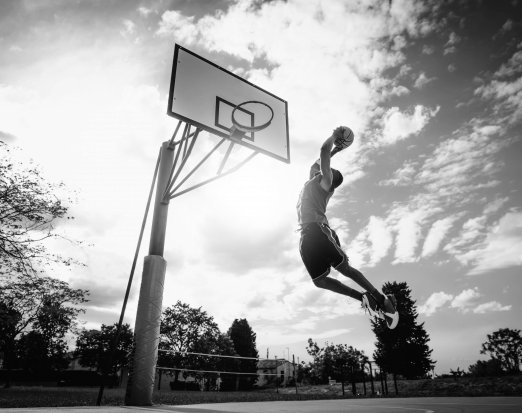The Impact of Strength & Conditioning in Youth Sports
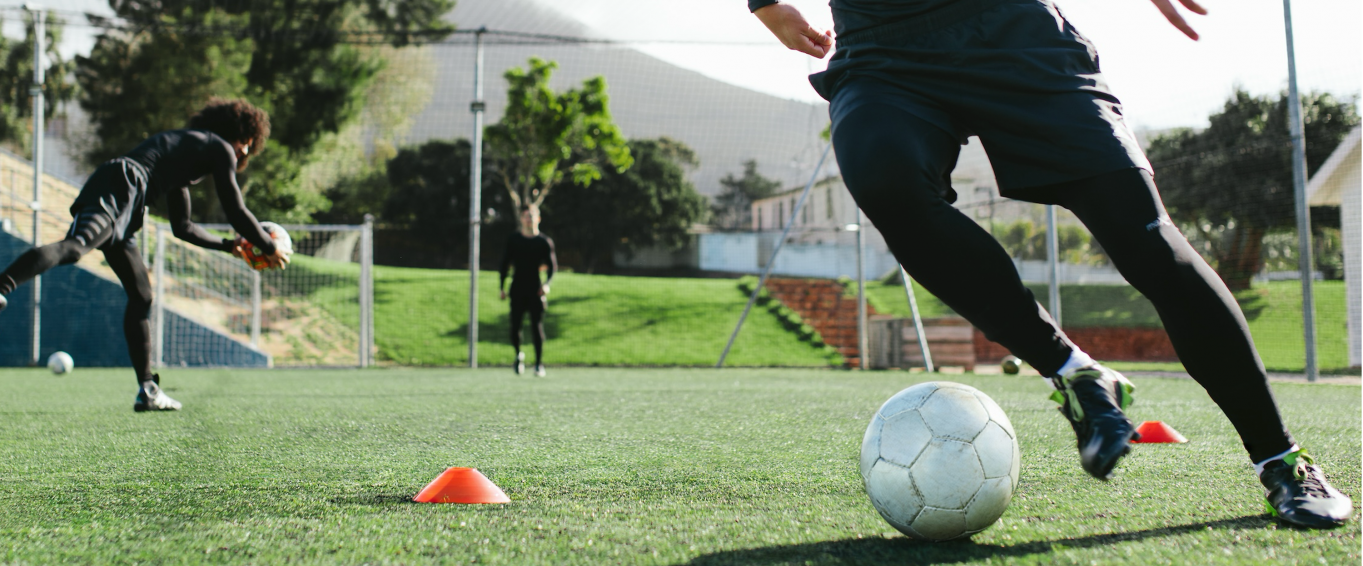
Recently, youth strength and conditioning has gained some popularity, due to social media posts, shares and videos of youths performing different modes of training, for example strength training, weightlifting, plyometrics, and sprints.
This new social media movement is encouraging, as it drives an important message and awareness to parents, sport coaches, sport directors and other individuals that youths enjoy trying different modes of training, plus, it hopefully motivates and inspires other youths to explore the true benefits of starting a strength and conditioning programme, including – improvements in health and wellbeing (confidence and self-esteem) (7, 24), injury reduction (1, 11, 26, 34, 36, 37) and sport performances (4, 9, 14, 15, 16).
Even with the social media exposure, unfortunately, the activity rates, especially in older youths (11 – 17 years old) are in free-fall, with 81% of youths not meeting the World Health Organisation guidelines (35). Worryingly, this is also true with strength levels, with a study reporting a sharp decline in strength amongst 10-year-olds from the UK. The study stated that strength levels in the bent-arm-hold, abdominal strength, and hand-grip strength had reduced by, 25.9%, 27.1%, and 6.3%, respectively (6). This concerning notion was also confirmed in American youths, where in the 1980’s, youths performing 6 – 10 repetitions of the modified-pull-up, would place them in the 50-percentile. Presently, this has declined to 2 – 4 repetitions to gain the same score (17).
A lack of strength development in youths is a clear risk of injury (2, 13, 19, 31). Furthermore, and this is an extremely important point, youths playing more sport, especially the same sport (sport specialisation), does not guarantee adequate levels of strength to match the demands of the sport. The lack of strength development unfortunately may lead to a greater injury risk and/or reduced sport performances. It is important to understand that more sport training and sport competition are a greater amount of volume – leading to fatigue and burnout (10).
Youth strength and conditioning, especially strength training, is a central component within a long-term athletic development programme (22), which every school, sport club, and academy should follow. Youth strength and conditioning, from a strategic perspective, has 3 key objectives:

Expose Youths to Different Modes of Training (strength, plyometrics, agility, and sprints)
By encouraging and offering strength and conditioning to youths and adolescents, this allows them to learn new skills (3) and improve physical capacities via a cascade of neuromuscular adaptations (18). From a term and age perspective, girls up to the age of 11-years, and boys up to the age of 13-years are referred to as youths, or young athletes. Girls over the age of 11-years and boys over the age of 13-years are referred to as adolescents. This approximate is aligned with maturation and pre-peak height velocity (ages 9 - 13 girls and 12 – 16 boys) (25).
Youths and young athletes should start in a long-term athletic programme, with their activities ranging from free-play, bodyweight training, tag games, and sprints as this will develop a host of motor skills (21). Furthermore, at this early age, strength and coordination should not be seen as separate components, as strength-coordination will be interlocked, and observed within motor skill development and performances (5). Youths and young athletes who start a long-term athletic development programme early, will develop these motor skills and strength-coordination, which can be seen as a prerequisite to other modes of training as they age. This has been demonstrated in youths (pre-peak height velocity) after completing plyometric training. The researchers reported improvements in their sprint times. Adolescents, however, reported improvements in their sprint times after completing a combination of strength and plyometric training (23).
To help primary schools in starting their children in a long-term athletic development programme, in-conjunction to regular PE, we have created both a PE Software and Total Sport App. The PE Software supports teachers with their PE lessons and the tracking of physical capacities and motor skills in their pupils. The Total Sport App encourages youths and young athletes to practice and learn a range of skills, hops, skips, sprints, bodyweight strength-coordination, balance, and dance patterns.
As youths grow and mature (post-peak height velocity), their body changes with a rapid increase in height, bodyweight, and a shift in hormones. These changes, however, may place the youths at a greater risk of injury, especially adolescent females, due to a reduction in relative strength and strength strategies (29) – strength level relative to bodyweight (kg). At this critical period of development, it is essential that adolescents regularly perform strength training, as strength training is the catalyst to force generation and production. In an analysis by Leinski (20), the researchers reported that youths and adolescents can significantly increase their strength by performing 1 – 3 strength training sessions per week, using mostly free-weight type exercises – you can read more about specific Youth Strength Training here.
The benefits of strength and conditioning training and exposing youths, young athletes, and adolescents to a wide range of activities, including strength training, plyometrics, agility, and sprints will lead to both health and wellbeing benefits, and motor performances – improvements in sprints, jump ability, and agility. A concurrent programme, which promotes a variation of training modes (strength, agility, sprints, and plyometrics) helps to keep youths and adolescents engaged in their physical development. This will ultimately aid in their enjoyment of training, the learning of new skills, boosting their knowledge of training and self-confidence.
Youth Strength & Conditioning can Reduce the Risk of Injuries
Unfortunately, the rate of injuries in youths and adolescents are on the increase (28), with most injuries being classified as overuse or sport-related injuries (30). We tend to discuss injuries within a multifactorial framework, which is understandable, however, a central part of reducing injuries in youths and adolescents is through starting a strength and conditioning programme, especially strength training (neuromuscular training) (27). Other important factors in reducing injuries are through monitoring of loads, minimising sport specialisation, and promoting optimal rest and recovery (26).
Strength training is both an effective and safe mode of training for youths and adolescents to regularly perform. This is mostly due to the ability to monitor the training. All aspects of a strength training programme can be considered, from exercise selection, load lifted, repetitions completed, and intra-rest periods. This allows the intensity (load lifted relative to the athlete’s 1RM) and training volume (repetitions x sets) to be monitored and tracked. Studies and meta-analyses have reported that injuries can be reduced by 30 – 42%, (33, 32), when youths and adolescents regularly perform neuromuscular training, which strength training, plyometrics, and agility are a part of. You can read more on Youth Injuries here.
By monitoring and tracking the youth’s and adolescents' strength levels, along with other key metrics, we can help to reduce the risk of injures, helping them to remain healthy, robust, and sport ready.

Support our Youths to be Sport Ready and to Improve Sport Performances
Every sport has a certain or specific demand, from rugby, to football, to netball. Youths and young athletes starting off in their sporting journey, will have fun learning the rules of the sport and developing their motor skills along the way. It is suggested that youths and young athletes adopt a multi-sport and multi-skilled physical development programme, including strength, plyometric, sprint, and agility activities, as this will reduce the risk of sport specialisation, injury, and burnout (21).
As youths and young athletes grow and develop into adolescents, their focus turns towards sporting performance. Through regular strength and conditioning training, this will prepare them for the demands of the sport (Sport Ready), but also help to improve performance characteristics that are used in most sports - sprints, agility, and jump ability (8, 12).
Summary
Youth strength and conditioning is a central part of a long-term athletic development programme. Youth strength and conditioning can start from an early age, with youths and young athletes learning motor skills, and strength-coordination, through free-play, jumps, hops, skips, bodyweight training, sprints, and dance patterns. As the youths mature, into adolescence their youth strength and conditioning programme develops with them, to enhance their relative strength, learn motor strategies in plyometrics, agility, and sprints.
Schools, sport clubs, and academies are perfectly positioned to offer and encourage regular strength and conditioning to their athletes, as a part of their youth physical development pathway. Collectively, this will reduce the risk of injures, boost their sport readiness, and allow them to perform at the highest level.
Youth Strength & Conditioning Platform for Schools, Sport Clubs, and Academies.
Our platform helps to deliver effective training and tracks athletic progress and development, with the core objectives of reducing the risk of injuries and to promote both sport readiness and performance. The platform’s features include -
- Strength and conditioning tests and dashboard to compare and contrast athlete metrics
- Athlete app - athletes can discover new exercises and train independently
- Track data - monitor athlete’s training loads, RPE, and training adherence
- Reports - simply create squad, team, and individual athlete reports
- Full curriculum - follow a strength and conditioning curriculum with a library of session plans
References
- Abernethy, L., & Bleakley, C. (2007). Strategies to prevent injury in adolescent sport: a systematic review. British Journal of Sports Medicine, 41(10), 627 – 638.
- Achenbach, L., Laver, L., Walter, S.S., Zeman, F., Kuhr, M., & Krutsch, W. (2020). Decreased external rotation strength is a risk factor for overuse should injury in youth elite handball athletes. Sports Medicine, 28, 1202 – 1211.
- Behringer, H., & Heede, A.V. (2011). Effects of strength training on motor performance skills in children and adolescents: A meta-analysis. Paediatric Exercise Science, 23, 186 – 206.
- Bourgeois, F.A., gamble, P., Gill, N.D., & McGuigan, M.R. (2017). Effects of a six-week strength programme on change of direction performance in youth team sport athletes. Sports, 5(83), 1 – 17.
- Cattuzzo, M.T., Dos Santos Henrique, R., Nicolai-Re, A, H., Santos de Oliveira, I., Melo, B.M., De Sousa Moura, M., Cappato de Araujo, R., & Stodden, D. (2016). Motor competence and health related physical fitness in youth: a systematic review. Journal of Science & Medicine in Sport, 19, 123 – 129.
- Cohen, D.D., Voss, C., Taylor, M.J.D., Delextrat, A., Ogunleye, A.A., & Sandercock, G.R.H. (2011). Ten-year secular changes in muscle fitness in English children. Acta Paediatrica, 100, 175 – 177.
- Collins, H., Booth, J.N., Duncan, A., Fawkner, S., & Niven, A. (2019). The effect of resistance training interventions on the ‘the self’ in youth: A systematic review and meta-analysis. Sports Medicine – Open, 5(29), 1 – 14.
- Comfort, P., Stewart, A., Bloom, L, & Clarkson, B. (2014). Relationships between, strength, sprint, and jump performances in well-trained youth soccer players. Journal Strength & Conditioning, 28(1), 173 - 177.
- Dasteridis, G., Pilianidis, T., & Mantzouranis, N. (2011). The effect of different strength training programmes on young athlete’s sprint performances, 18(2), 141 – 147.
- Field, A.E., Tepolt, F.A., Yang, D.S., & Kocher, M.S. (2019). Injury risk associated with sports specialisation and activity volume in youth. The Orthopaedic Journal of Sports Medicine, 7(9), 1 – 6.
- Hanlon, C., Krzak, J.J., Prodoehl, J., & Hall, K.D. (2020). Effect of injury prevention programmes on lower extremity performance in youth athletes: A systematic review. Sports Health, 12(1), 12 – 22.
- Harries, S.K., Lubans, D.R., & Callister, R. (2012). Resistance training to improve power and sports performance adolescent athletes: a Systematic review and meta-analysis. Journal of Science and Medicine in Sport, 15, 532 – 540.
- Hietamo, J., Pasanen, K., Leppänen, M., Steffen, K., Kannus, P., Heinonen, A., Mattila, V., & Parkkari, J. (2021). Association between lower extremity muscle strength and acute ankle injury in youth team-sports athletes. Physical Therapy in Sport, 48, 188-195.
- Karagianni, K., Donti, O., Katsikas, C., & Bogdanis, G.C. (2020). Effects of supplementary strength-power training on neuromuscular performance in young female athletes. Sports, 8, 9 – 20.
- Keiner, M., Kadlubowski, B., Sander, A., Hartmann, H., Wirth, K. (2022). Effects of 10-months of speed, functional, and traditional strength training on strength, linear sprint, change of direction, and jump performance in trained adolescent soccer players. Journal of Strength & Conditioning Research, 1(36), 2236 – 2246.
- Kobal, R., Loturco, I., Barroso, R., Gol, S., Cuniyochi, R., Ugrinowitsch, C., Roschel, H., & Tricoli, V. (2017). Effects of different combinations of strength, power, and plyometric training on the physical performance of elite young soccer players. Journal of Strength & Conditioning Research, 31(6), 1468 - 1476.
- Laurson, K.R., Saint-Maurice, P.F., welk, G.J., & Eisenmann, J.C. (2017). References curves for field-based tests of musculoskeletal fitness in U.S. children and adolescents: the 2012 NHANES national youth fitness survey. Journal Strength & Conditioning, 31, 2075 – 2082.
- Legerlotz, K., Marzilger, R., Bohm, S., & Arampastzis, A. (2016). Physiological adaptations following resistance training in youth athletes – a narrative review. Paediatric Exercise Science, 28, 501 – 520.
- Lehnert, M., Croix, M., Hughes, J., Varekova, R., & Lastovicka, O. (2016). Muscular and neuromuscular control following soccer-specific exercise in male youth: changes in injury risk mechanisms. Scandinavian Journal of Medicine & Science in Sports, 27(9), 975 – 982.
- Lesinski, M., Prieske, O., Granacher, U. (2016). Effects and dose-response relationships of resistance training on physical performances in youth athletes. A systemic review and meta-analysis. British Journal of Sports Medicine, 50, 781 – 795.
- Llyod, R.S., & Oliver, J.L. (2012). The youth physical development model: a new approach to long-term athletic development. Strength & Conditioning Journal, 34(3), 61 – 72.
- Llyod, R.S., Oliver, J.L., Faigenbaum, A.D., Howard, R., Croix, M., Williams, C.A., Best, T.M., Alvar, B.A., Micheli, L.J., Thomas, D.P., Hatfield, D., Cronin, J.B., & Myer, G.D. (2015). Long-term athletic development: part 1 – A pathway for all youth. Journal of Strength & Conditioning Research, 29(5), 1439 – 1450.
- Llyod, R.S., Radnor, J.M., De-Ste Croix, M.B.A., Cronin, J.B., & Oliver, J.L. (2016). Changes in sprint and jump performance after traditional, plyometric, and combined resistance training in male youth pre-and-post peak height velocity. Journal of Strength and Conditioning Research, 30, 1239 – 1247.
- Lubans, D.R., Aguiar, E.J., & Callister, R. (2010). The effects of free weights and elastic tubing resistance training on physical self-perception in adolescents. Psychology of Spot & Exercise, 11, 497 – 504.
- Malina, R.M., Koziel, S.M., Kralik, M., Chrzanowska, M., & Suder, A. (2020). Prediction of maturity offset and age at peak height velocity in a longitudinal series of boys and girls. American Journal of Human Biology, 33(6), 1 – 15.
- Merkel, D.L. (2013). Youth sport: positive and negative impact on young athletes. Journal of Sports Medicine, 4, 151 - 160
- Myer, G.D., Faigenbaum, A.D., Ford, K.R., Best, T.M., Bergeron, M.F., & Hewett, T.E. (2011). When to initiate integrative neuromuscular training to reduce sports-related injuries and enhance health in youth? Current Sports Medicine Reports, 10(3), 155 – 166.
- Prieto-Gonzalez, P., Martinez-Castillo, J.L., Fernandez-Galvan, L.M., Casado, A., Soporki, S., & Sanchez-Infante, J. (2021). Epidemiology of sports-related injuries and associated risk factors in adolescent athletes: An injury surveillance. International Journal of Environmental Research and Public Health, 18, 1 – 16.
- Quatmann, C.C., Myer, G.D., Ford, K.R., & Hewett, T.E. (2013). A longitudinal evaluation of maturational effects on lower extremity strength in female adolescent athletes. Pediatr Physical Therapy, 25(3), 271 – 276.
- Rejeb, A., Johnson, A., Vaeyens, R., Horobeanu, C., Farooq, A., & Witvrouw, E. (2107). Compelling overuse injury incidence in youth multisport athletes. European Journal od Sport Science, 4, 495 – 502.
- Ridder, R., Witvrouw, E., Dolphens, M., Roosen, P., & Ginckel, A. (2017). Hip strength as an intrinsic risk factor for lateral ankle sprains in youth soccer players: a 3-season prospective study. American Journal of Sports Medicine, 45(2), 410 – 416.
- Sadigursky, D., Almeida-Braid, J., Lemos De Lia, D.N., Machado, B.A.B., Carneiro, R.J.F., & Colavolpe, P.O. (2017). The FIFA 11+ injury prevention program for soccer players: a systematic review. BMC Sports Science, Medicine & Rehabilitation, 9(18), 1 – 8.
- Steib, S., Rahlf, A.L., Pfeifer, K., & Zech, A. (2017). Dose-response relationship of neuromuscular training for injury prevention in youth athletes: A meta-analysis. Frontiers in Physiology, 8, 1 – 17.
- Weber, M.L, & Lam, K.C (2016). The effectiveness of injury prevention programmes for youth and youth adolescent athletes. Human Kinetics, 21(2), 25 – 31.
- World Health Organisation. Global action plan on physical activity 2018 – 2030: More active people for a healthier world. WHO (2018).
- Zouita, S., Zouita, A.B.M., Kebsi, W., Dupont, G., Abderrahman, A.B., Salah, F.Z.B., & Zouhal, H. (2016). Strength training reduces injury rate in elite youth soccer players during one season. Journal Strength & Conditioning Research, 30(5), 1295 – 1307.
- Zwolski, C., Quatman-Yates, C., & Paterno, M.V. (2017). Resistance training in youth: Laying the foundation for injury prevention and physical literacy. Sports Health, 9(5), 436 – 443.
